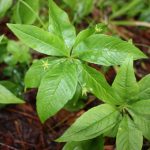Starflower
Prepared by Jennifer L. D’Appollonio, Assistant Scientist, University of Maine, Orono, ME 04469. Updated February 2018.
Scientific name: Trientalis borealis Raf.; also Lysimachia borealis (Raf.) U. Manns & A. Anderb.
Common name(s): starflower
Links: USDA PLANTS Profile , NPIN Profile, Go Botany
Images: (to see enlargements [PC]: click on image, then right click and choose “view image”)
- near wooded edge of blueberry field
- in flower, end of May
- old flowers, early June
Description:
– perennial
-primrose family
-spreads by creeping rhizomes
-leaves are:
- simple
- whorled
- entire to finely toothed
– typically has 7 petals, but can range 5-10
– generally flowers spring to mid-June in ME
– generally fruits June to August in ME
Habitat:
-deciduous and coniferous forests
-shaded moist woods
-successional old fields
-also can thrive in dry, sandy, acidic soils
Agriculture:
-pollinated by native bees
Natural History:
-its Latin name means “one third of a foot” which corresponds to its average height
Source(s):
Hansen, R.W., S.B. Hansen and E.A. Osgood. 1991. Reproductive phenologies of selected flowering plants in eastern Maine forests. ME Agric. Exp. Station Tech. Bull. 143. 17 pp.
Heinrich, B. 1976. Flowering phenologies: Bog, woodland, and disturbed habitats. Ecology. 57(5):890-899.
Stritch, Larry. “Starflower (Trientalis Borealis Raf.).” Plant of the Week, U.S. Forest Service, www.fs.fed.us/wildflowers/plant-of-the-week/trientalis_borealis.shtml.



